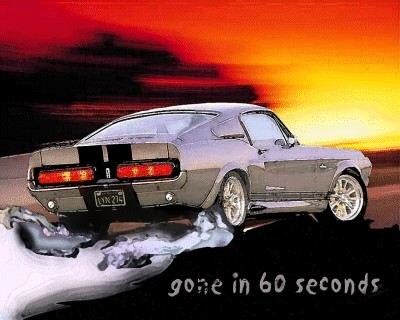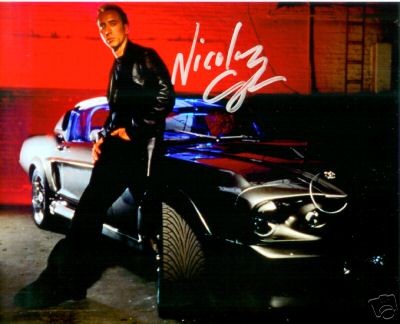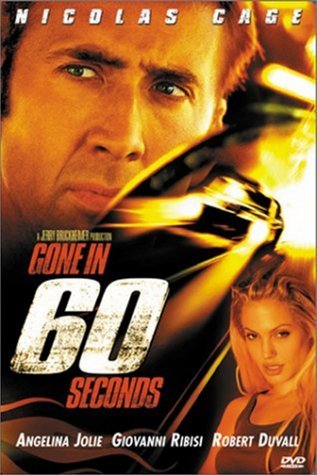




Whatever its merits as a film, Gone in 60 Seconds was required viewing for all Mustang lovers. After all, it's not often that Hollywood makes a movie starring a car ! And the Mustang in Gone in 60 Seconds was definitely the star. What's with that Mustang? And the movie? Those are questions substantial enough to build a story upon.And despite the fact that not everything makes sense in the movie (such as hitting the nitrous when the engine is already turning 7,000 rpm :-), we know you're going to buy the video….
The Movie:
While the 2000 version of Gone In Sixty Seconds is obviously inspired by1974's Gone in 60 Seconds, it's really not a remake. Although both titles are pronounced the same, technically, they're not identical because the title of the newer movie spells out the word sixty and the old title uses the number (even though the poster for the new movie uses the number). "The major appeal of Gone in 60 Seconds - and it is considerable - is that it is a genuine primitive work of art," says the Los Angeles Times, upon the original's release.
Art or not, the idea for the remake germinated at Disney and wound up in the hands of producer Jerry Bruckheimer. Bruckheimer produced Flashdance (probably not a top pick for the guys in the audience), Top Gun, and Days of Thunder with his late partner, Don Simpson, and such recent hits as Armageddon, The Rock, and Con Air on his own. With a script from Scott Rosenberg, who penned Con Air, Bruckheimer recruited Nicolas Cage to star and TV commercial director Dominic Sena to direct. Throw in a supporting cast that included Oscar winners Robert Duvall and Angelina Jolie and hopefully the result would be a hit.
The story is similar to the original in that a group of car thieves needs to steal 50 cars in a 24-hour period. The makers of the new movie threw in a threat to the life of lead character Memphis Raines' (Cage) brother, Kip (Giovanni Ribisi), to add some emotional wallop to the film, but people were going to see this movie based on the quality of the action. And the action would include a big car chase featuring, as in the original movie, a Mustang named ELEANOR !
Creating Eleanor:
When the movie started production, Eleanor wasn't necessarily going to be a Mustang at all. "We really wanted to see a GT40 blowing through downtown L.A., flying down the L.A. River", says production designer Jeff Mann. But even for a movie that cost a reported $90 million in 2000 to make, a fleet of GT40s was prohibitively expensive ! So it was back to Mustangs.
"We were looking at a '67 GT500. It's a bitchin' car, no doubt,"continues Mann, "but does it really stack up against these othervehicles?" This is a pertinent concern in a film that would be overstuffed with Ferraris. "In the context of all these other cars, it's not necessarily going to be the hottest thing going down the road, or? That's when Jerry kind of opened the doors for me to come up with a variation on it . . . ." Building the variation that didn't suck started with famed Hot Rod illustrator Steve Stanford, who drew up an illustration of an over-the-top '67 GT500. This is how the Mustang Shelby GT500 Eleanor was born !
Former Boyd Coddington designer Chip Foose was hired by the production company to turn Stanford's work into a reality. Foose fitted the car with PIAA lights in both the nose and rear backup areas. He also prototyped the hood, the front valance, the side skirts, the scoops, and all the other fiberglass parts that would be used for the car. That billetgrille is based on pieces originally developed for ChevyAstro vans and Foose found the Schmidt 17x8-inch wheels that would be sheathed in P245/40ZR17 Goodyear Eagle F1 tires.
Filming Eleanor
While star Nicolas Cage did a surprising amount of the driving in Gone, the heavy lifting was done by a team of Hollywood’s best stunt drivers. “We’ve had a lot of man days on this show,” says stunt coordinator Johnny Martin. “It’s been nothing but weaving through traffic and dodging cars. And we did a lot of chase scenes in the middle of the day, through downtown L.A., so that pretty much causes a lot of traffic. We’ve had more than 350 guys work in it [the movie].” However, having Cage in the car most of the time allowed the director to better create the illusion that he was driving all the time.
Neither the side-exit exhausts nor the C-pillar-mounted fuel fillers ('71 Mach fuel doors) were functional on the cars seen in the movie. Why? First, because actually making the side exhausts work is tough, considering how the '67 Mustang is built. And second, because they didn't need to be functional.










